Unknown to about anybody but cognescenti of the marque, the Mazda RX-2 was one of the earliest rotary-powered cars sold in North America. Successor of the R100 (which sold in extremely limited numbers), it was introduced in 1970 and succeeded by the RX-3, RX-4, RX-5 and, in 1978, the 1st generation RX-7.
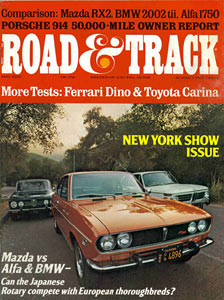
|
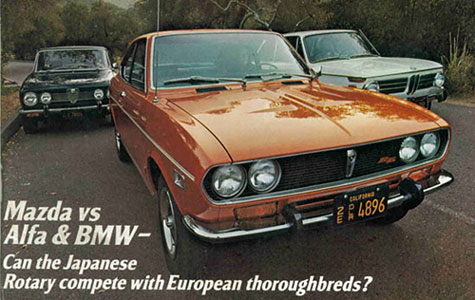
|
Click on any of the above images for a full-size view
The RX-2 won several motoring awards including Motor Trends' Import Car of the Year. The car was powered by a 12A twin rotor rotary engine of only 70 cubic inches (slightly less than 1,200cc), hence the name. Equipped with unique twin distributors, it produced 120hp in emission-compliant US trim, enough for the lightweight to give contemporary sports sedans and coupes of the time a run for their money. In fact, even with the ancient smog equipment in place, the RX-2 was faster than even the fastest BMW sports sedan of the time, the legendary BMW 2002tii.
A sleeper? You bet!
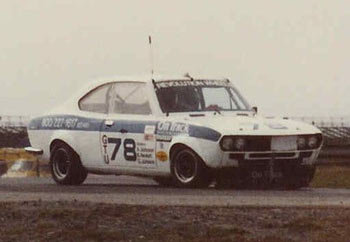
|
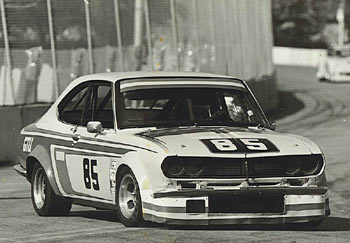
|
Click on any of the above images for a full-size view
Mazda RX-2s were true dragon slayers and raced briefly, but very successfully in SCCA and IMSA against much more powerful competition, before they were replaced by the RX-3s.
Having learned to appreciate rotary-powered cars during my SCCA road racing days, I couldn't resist when the opportunity arose to buy a blue plate California RX-2 Coupe for very little money from the 2nd owner who got the car in 1979 as a high school graduation present.
I knew it would be the perfect sleeper, a car that I with very little effort could turn into a 180hp road rocket, fast enough to leave even contemporary Porsche 911s in the dust.
Inspecting the car closer and researching the market, I changed my mind. Turns out that virtually no Mazda RX-2 Coupes exist that haven't been modified. None. My car, however, is the exception. Everything aside from its cheap, oxidized, and plain wrong paint job it is factory correct, from the twin-dizzy engine down to the paint on the rims, the smog pump, and the thermal reactor with afterburner exhaust pipe.
Hence, originality is king so I will keep it bone stock, aside from the dreadful and power-robbing smog equipment and some minor, period-correct upgrades.
Originally a silver-blue metallic car (paint code B5 = Galac Silvermetallic), the little Mazda received a half-hearted color change a quarter Century ago. Under the meanwhile heavily oxidized budget paint lurks healthy metal. Aside from some tiny rust spots around the windshield there's no corrosion to be found anywhere. Luckily, the car has also never been involved in any kind of accident!
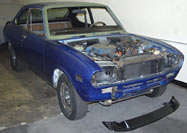
|
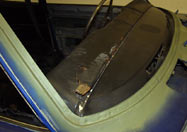
|
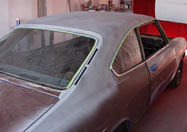
|
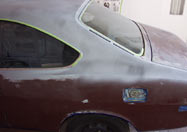
|
Click on any of the above images for a full-size view
I disassembled the entire car, carefully--labeling everything--after which the rusted metal around the windshield was professionally repaired by vintage Porsche restoration specialist Joe George. Since a healthy basis is essential for a quality paint job, we stripped the non-original paint section for section down to the factory primer, using razor blades and buckets of ellbow grease. A slave job that seemed to take forever!
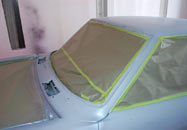
|
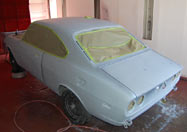
|
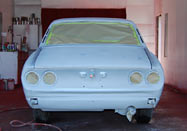
|
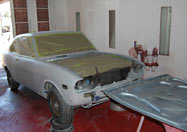
|
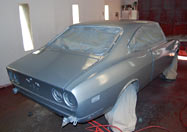
|
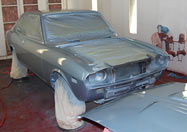
|
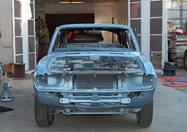
|
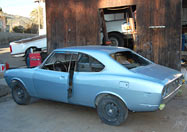
|
Click on any of the above images for a full-size view
Months later, on August 15, 2007, the car was finally re-painted in its original color by Leo's Paint & Body. What we did not touch was the engine compartment, the interior, and the trunk, as these areas had not been color-changed and were still all factory original and nicely preserved. As you can see, everything was taken out, including all of the windows, which improves the results tremendously and doesn't cost much, aside from time, lots of time. But who counts time spent on a hobby project anyway?